A GIS-Based Framework Creating Green Stormwater Infrastructure Inventory Relevant to Surface Transportation Planning
Abstract
1. Introduction
2. Structure of the GIS-Based Framework
2.1. An Overview of the Framework
2.2. Data Requirements
2.3. Categorizing the Roads with Potential Implemented GSI Nearby
2.4. Mapping GSI Relevant to Transportation
2.5. Identifying GSI Types from Visual Features
3. Framework Testing
3.1. Test Area and Results
3.2. Accuracy Assessment
4. Framework Application
4.1. Study Area
- A region in the scale of watershed or subwatershed;
- A region under flood risk;
- An area consisting of diverse land uses.
4.2. Results and Discussion
5. Conclusions
Author Contributions
Funding
Acknowledgments
Conflicts of Interest
References
- Forman, R.T.; Alexander, L.E. Roads and their major ecological effects. Annu. Rev. Ecol. Syst. 1998, 29, 207–231. [Google Scholar] [CrossRef]
- Line, D.E.; White, N.M. Effects of development on runoff and pollutant export. Water Environ. Res. 2007, 79, 185–190. [Google Scholar] [CrossRef] [PubMed]
- Wendel, H.E.W.; Downs, J.A.; Mihelcic, J.R. Assessing equitable access to urban green space: The role of engineered water infrastructure. Environ. Sci. Technol. 2011, 45, 6728–6734. [Google Scholar] [CrossRef] [PubMed]
- Bowen, K.J.; Lynch, Y. The public health benefits of green infrastructure: The potential of economic framing for enhanced decision-making. Curr. Opin. Environ. Sustain. 2017, 25, 90–95. [Google Scholar] [CrossRef]
- Demuzere, M.; Orru, K.; Heidrich, O.; Olazabal, E.; Geneletti, D.; Orru, H.; Bhave, A.; Mittal, N.; Feliu, E.; Faehnle, M. Mitigating and adapting to climate change: Multi-functional and multi-scale assessment of green urban infrastructure. J. Environ. Manag. 2014, 146, 107–115. [Google Scholar] [CrossRef] [PubMed]
- Suppakittpaisarn, P.; Jiang, X.; Sullivan, W.C. Green Infrastructure, green stormwater infrastructure, and human health: A review. Curr. Landsc. Ecol. Rep. 2017, 2, 96–110. [Google Scholar] [CrossRef]
- Belizario, P.; Scalize, P.; Albuquerque, A. Heavy metal removal in a detention basin for road runoff. Open Eng. 2016, 6, 412–417. [Google Scholar] [CrossRef]
- Lucas, S.; Clar, M.; Gracie, J.A. Green street retrofit in a Chesapeake Bay community using bioswales. In Proceedings of the 2011 Low Impact Development Conference, Philadelphia, PA, USA, 25–28 September 2011. [Google Scholar] [CrossRef]
- Lucke, T.; Nichols, P.W. The pollution removal and stormwater reduction performance of street-side bioretention basins after ten years in operation. Sci. Total Environ. 2015, 536, 784–792. [Google Scholar] [CrossRef]
- Li, J.; Liang, Z.; Gao, Z.; Li, Y. Experiment and simulation of the purification effects of multi-level series constructed wetlands on urban surface runoff. Ecol. Eng. 2016, 91, 74–84. [Google Scholar] [CrossRef]
- Pennino, M.J.; McDonald, R.I.; Jaffe, P.R. Watershed-scale impacts of stormwater green infrastructure on hydrology, nutrient fluxes, and combined sewer overflows in the mid-Atlantic region. Sci. Total Environ. 2016, 565, 1044–1053. [Google Scholar] [CrossRef]
- Roy, A.H.; Wenger, S.J.; Fletcher, T.D.; Walsh, C.J.; Ladson, A.R.; Shuster, W.D.; Thurston, H.W.; Brown, R.R. Impediments and solutions to sustainable, watershed-scale urban stormwater management: Lessons from Australia and the United States. J. Environ. Manag. 2008, 42, 344–359. [Google Scholar] [CrossRef] [PubMed]
- Rowe, A.; Rector, P.; Bakacs, M. Survey results of green infrastructure implementation in New Jersey. J. Sustain. Water Built. Environ. 2016, 2, 04016001. [Google Scholar] [CrossRef]
- Georgetown Climate Center. Green Infrastructure Toolkit. Available online: https://www.georgetownclimate.org/adaptation/toolkits/green-infrastructure-toolkit/introduction.html?full (accessed on 13 November 2018).
- US EPA. How Do You Select Good Sites for Green Infrastructure? Available online: https://www.epa.gov/sites/production/files/2015-11/documents/how_to_determine_best_opportunites_for_green_infrastructure.pdf (accessed on 15 August 2017).
- US EPA. Green Infrastructure Opportunities and Barriers in the Greater Los Angeles Region (EPA 833-R-13-001); US Environmental Protection Agency: Los Angeles, CA, USA, 2013.
- US EPA. Coastal Stormwater Management Through Green Infrastructure a Handbook for Municipalities (EPA 842-R-14-004); US Environmental Protection Agency: Washington, DC, USA, 2014.
- Huron River Watershed Council. Guide to Green Infrastructure Opportunity Maps for Washtenaw County. Available online: https://www.hrwc.org/wp-content/uploads/2014/03/Guide-to-GI-Opportunities-v2.pdf (accessed on 15 August 2017).
- Cleland, B.; Karll, K. Identify your green infrastructure priorities. In Proceedings of the Great Lakes and St. Lawrence Green Infrastructure Conference, Detroit, MI, USA, 31 May–2 June 2017. [Google Scholar]
- Meerow, S.; Newell, J.P. Spatial planning for multifunctional green infrastructure: Growing resilience in Detroit. Landsc. Urban Plan. 2017, 159, 62–75. [Google Scholar] [CrossRef]
- Dennis, M.; Barlow, D.; Cavan, G.; Cook, P.A.; Gilchrist, A.; Handley, J.; James, P.; Thompson, J.; Tzoulas, K.; Wheater, C.P. Mapping urban green infrastructure: A novel landscape-based approach to incorporating land use and land cover in the mapping of human-dominated systems. Land 2018, 7, 17. [Google Scholar] [CrossRef]
- Labib, S.M.; Harris, A. The potentials of Sentinel-2 and LandSat-8 data in green infrastructure extraction, using object based image analysis (OBIA) method. Eur. J. Remote Sens. 2018, 51, 231–240. [Google Scholar] [CrossRef]
- Liquete, C.; Kleeschulte, S.; Dige, G.; Maes, J.; Grizzetti, B.; Olah, B.; Zulian, G. Mapping green infrastructure based on ecosystem services and ecological networks: A Pan-European case study. Environ. Sci. Policy 2015, 54, 268–280. [Google Scholar] [CrossRef]
- Wang, J.X.; Banzhaf, E. Derive an understanding of Green Infrastructure for the quality of life in cities by means of integrated RS mapping tools. In Proceedings of the 2017 Joint Urban Remote Sensing Event (JURSE), Dubai, UAE, 6–8 March 2017. [Google Scholar] [CrossRef]
- Hale, R.L.; Turnbull, L.; Earl, S.R.; Childers, D.L.; Grimm, N.B. Stormwater infrastructure controls runoff and dissolved material export from arid urban watersheds. Ecosystems 2015, 18, 62–75. [Google Scholar] [CrossRef]
- City of Philadelphia. Green Stormwater Infrastructure—SMP Footprints. Available online: http://metadata.phila.gov/#home/datasetdetails/5543864320583086178c4e6f/representationdetails/56eaddf28597748205e975da/ (accessed on 16 August 2017).
- Philadelphia Water Department. Green Stormwater Infrastructure (GSI) Planning Guidelines. Available online: http://phillywatersheds.org/doc/GSI/150305_PWDGSI_Planning_Guidelines_Version1.0.pdf (accessed on 15 March 2018).
- Tu, M.-C.; Traver, R. Clogging impacts on distribution pipe delivery of street runoff to an infiltration bed. Water 2018, 10, 1045. [Google Scholar] [CrossRef]
- US EPA. What Is Green Infrastructure? Available online: https://www.epa.gov/green-infrastructure/what-green-infrastructure (accessed on 15 March 2018).
- WERF. User’s Guide to the BMP and LID Whole Life Cost Models Version 2.0 (Report SW2R08); Water Environment & Reuse Foundation: Alexandria, VA, USA, 2009. [Google Scholar]
- McPhillips, L.E.; Matsler, A.M. Temporal evolution of green stormwater infrastructure strategies in three US cities. Front. Built Environ. 2018, 4, 26. [Google Scholar] [CrossRef]
- City of Tampa. City of Tampa GeoHub. Available online: http://city-tampa.opendata.arcgis.com/ (accessed on 20 August 2017).
- USF Water Institute. Tampa Tree Canopy and Land Cover. Available online: http://waterinstitute.maps.arcgis.com/apps/Viewer/index.html?appid=7fa10b957c4d4ee6a4a5bb91f9316118 (accessed on 20 August 2017).
- U.S. Geological Survey. The National Map—TNM Download. Available online: https://viewer.nationalmap.gov/basic/ (accessed on 30 August 2017).
- Florida DOT. Manual of Uniform Minimum Standards for Design, Construction and Maintenance for Streets and Highways (Topic# 625-000-015); Florida Department of Transportation: Tallahassee, FL, USA, 2016.
- Pitt, S.; Pitt, R.; Field, R.; Tafuri, A.N.; Khalid, A.; Reddy, F.; O’Bannon, D. Use of green infrastructure integrated with conventional gray infrastructure for combined sewer overflow control: Kansas City, MO. In Proceedings of the Water Environment Federation, WEFTEC 2011, Los Angeles, CA, USA, 16–19 October 2011. [Google Scholar]
- US EPA. Green Infrastructure Permitting and Enforcement Series Fact Sheet 3: Sanitary Sewer Overflows (EPA 832F12014); US Environmental Protection Agency: Washington, DC, USA, 2012.
- NSCTO. Urban Street Design Guide—Lane Width. Available online: https://nacto.org/publication/urban-street-design-guide/street-design-elements/lane-width/ (accessed on 10 August 2017).
- Florida DOT. Roadway Design Bulletin 14-17: Urban Arterial Lane Width and Bicycle Lane Options; Florida Department of Transportation: Tallahassee, FL, USA, 2014.
- Florida DOT. Driveway Information Guide; Florida Department of Transportation: Tallahassee, FL, USA, 2008.
- Purvis, R.A.; Winston, R.J.; Hunt, W.F.; Lipscomb, B.; Narayanaswamy, K.; McDaniel, A.; Lauffer, M.S.; Libes, S. Evaluating the Water Quality Benefits of a Bioswale in Brunswick County, North Carolina (NC), USA. Water 2018, 10, 134. [Google Scholar] [CrossRef]
- Vestergren, S. Infiltration Trenches in Scania: A Study of the Hydraulics and the Pollutant Removal Effect. Master Thesis, Lund University, Lund, Sweden, 2010. [Google Scholar]
- Bicudo, J.; Stone, R.P.; Pastrik, E.; Patterson, J.; Hazlewood, P.P.; Mlynarz, D. Vegetated Filter Strip Design—Overview and Case Study. In Proceedings of the 2006 ASAE Annual Meeting, St. Joseph, MI, USA, 9–12 July 2006. [Google Scholar] [CrossRef]
- Minnesota Pollution Control Agency. Minnesota Stormwater Manual—Vegetated Filter Strips. Available online: https://stormwater.pca.state.mn.us/index.php?title=Vegetated_filter_strips (accessed on 13 September 2017).
- OpenDataPhilly.com. Open Data in the Philadelphia Region. Available online: https://www.opendataphilly.org/ (accessed on 30 March 2018).
- CityMart. Philadelphia Green Stormwater Infrastructure Program. Available online: https://www.citymart.com/philadelphia-gsi (accessed on 30 March 2018).
- USFWS. Accuracy Assessment. Available online: https://www.fws.gov/gisdownloads/R8/individual/Justin/RS_presentations/11%20Accuracy%20assessment.pptx (accessed on 31 March 2018).
- New Jersey Department of Environmental Protection. New Jersey Stormwater Best Management Practices Manual Chapter 9.1: Bioretention Systems; New Jersey Department of Envrionmental Protection: Trenton, NJ, USA, 2009.
- New Jersey Department of Environmental Protection. New Jersey Stormwater Management Technical Manual Chapter 6.12: Wet Ponds; New Jersey Department of Environmental Protection: Trenton, NJ, USA, 2011.
- U.S. Geological Survey. Watershed Boundary Dataset. Available online: https://www.usgs.gov/core-science-systems/ngp/national-hydrography/watershed-boundary-dataset?qt-science_support_page_related_con=4#qt-science_support_page_related_con (accessed on 20 August 2017).
- Liu, W.; Chen, W.; Peng, C. Assessing the effectiveness of green infrastructures on urban flooding reduction: A community scale study. Ecol. Model. 2014, 291, 6–14. [Google Scholar] [CrossRef]
- Tzoulas, K.; Korpela, K.; Venn, S.; Yli-Pelkonen, V.; Kaźmierczak, A.; Niemela, J.; James, P. Promoting ecosystem and human health in urban areas using Green Infrastructure: A literature review. Landsc. Urban Plan. 2007, 81, 167–178. [Google Scholar] [CrossRef]
- Allen, W.L. Environmental reviews and case studies: Advancing green infrastructure at all scales: From landscape to site. J. Environ. Pract. 2012, 14, 17–25. [Google Scholar] [CrossRef]
- Pochee, H.; Johnston, I. Understanding design scales for a range of potential green infrastructure benefits in a London Garden City. Build. Serv. Eng. Res. Technol. 2017, 38, 728–756. [Google Scholar] [CrossRef]
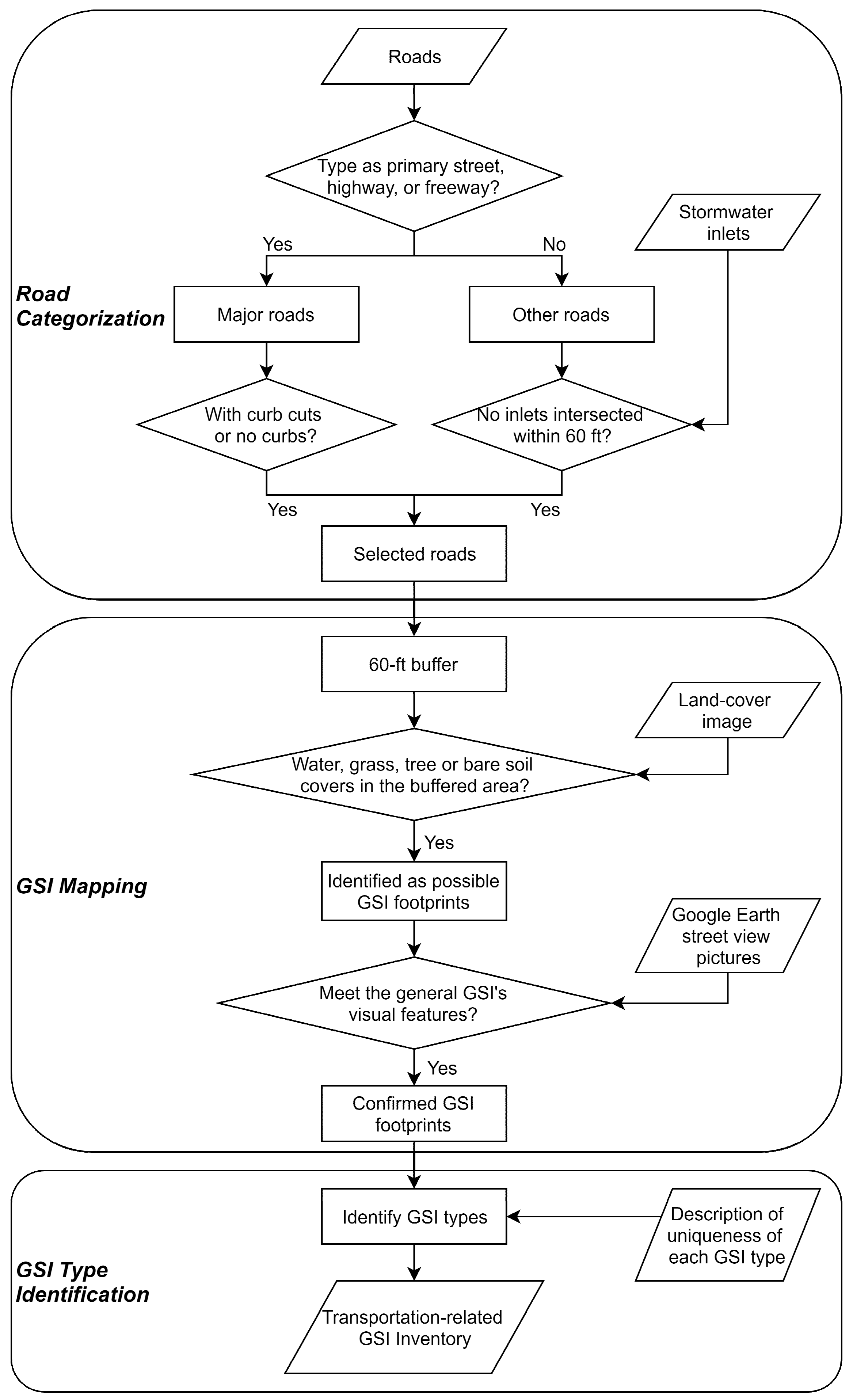
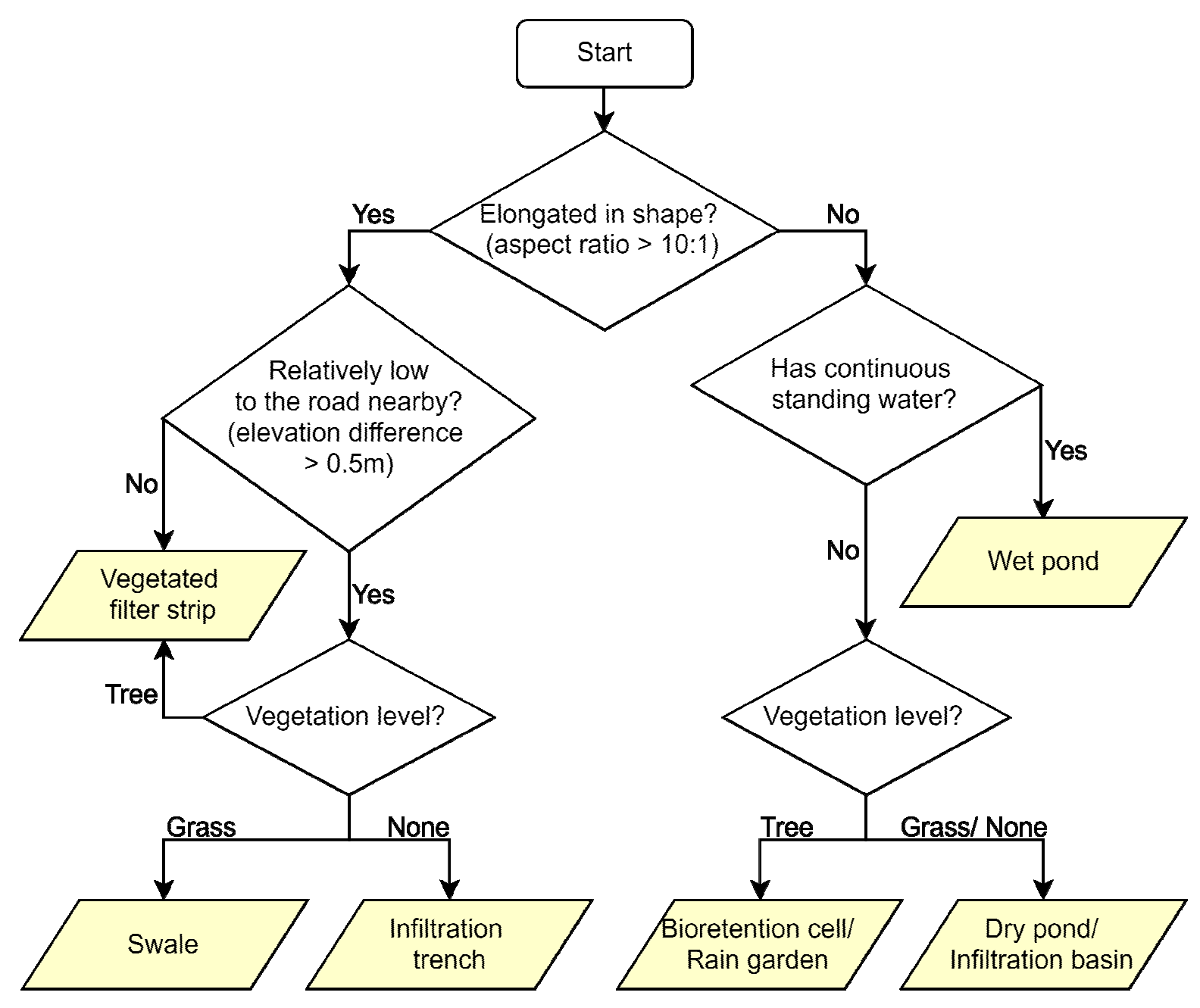
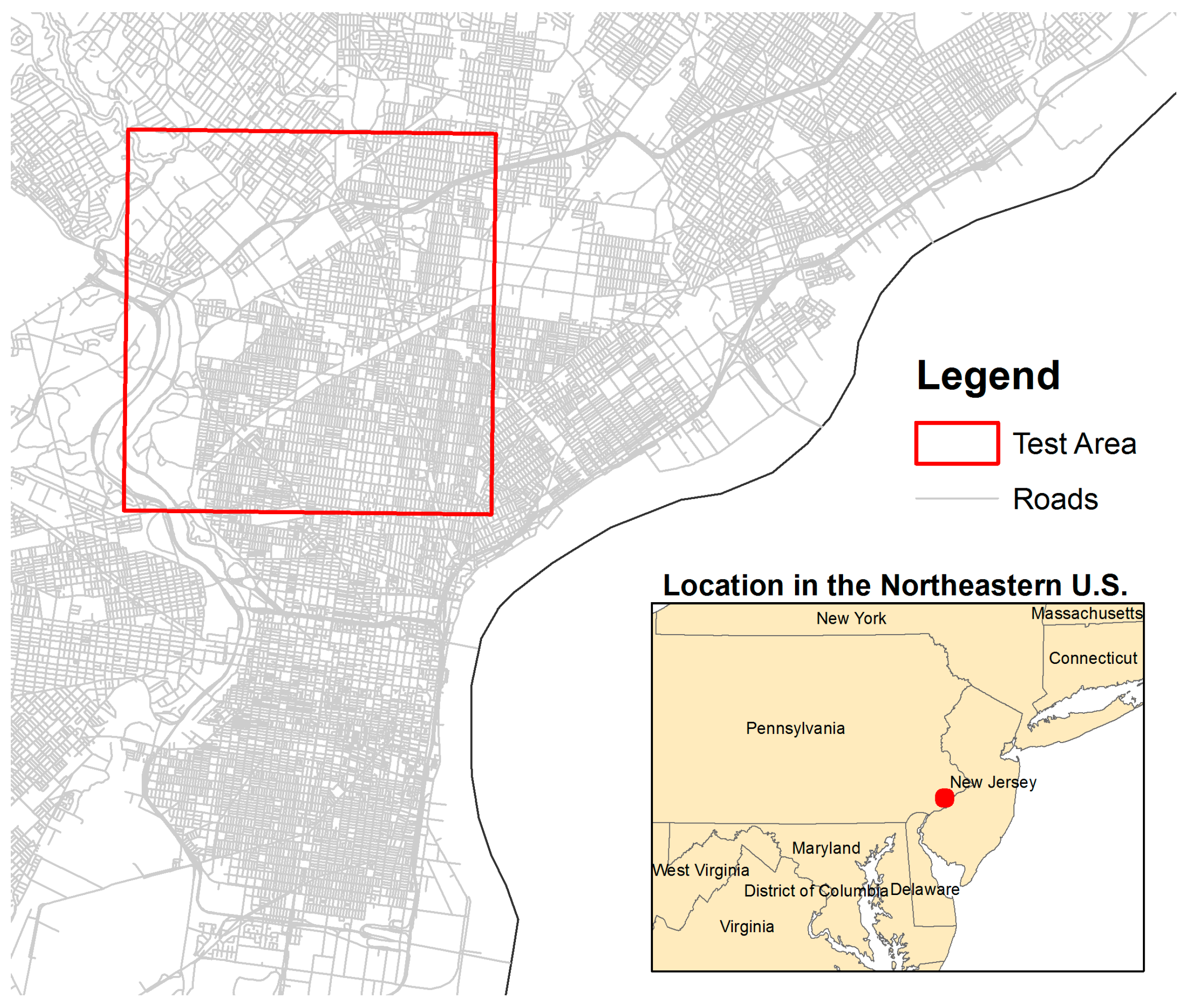
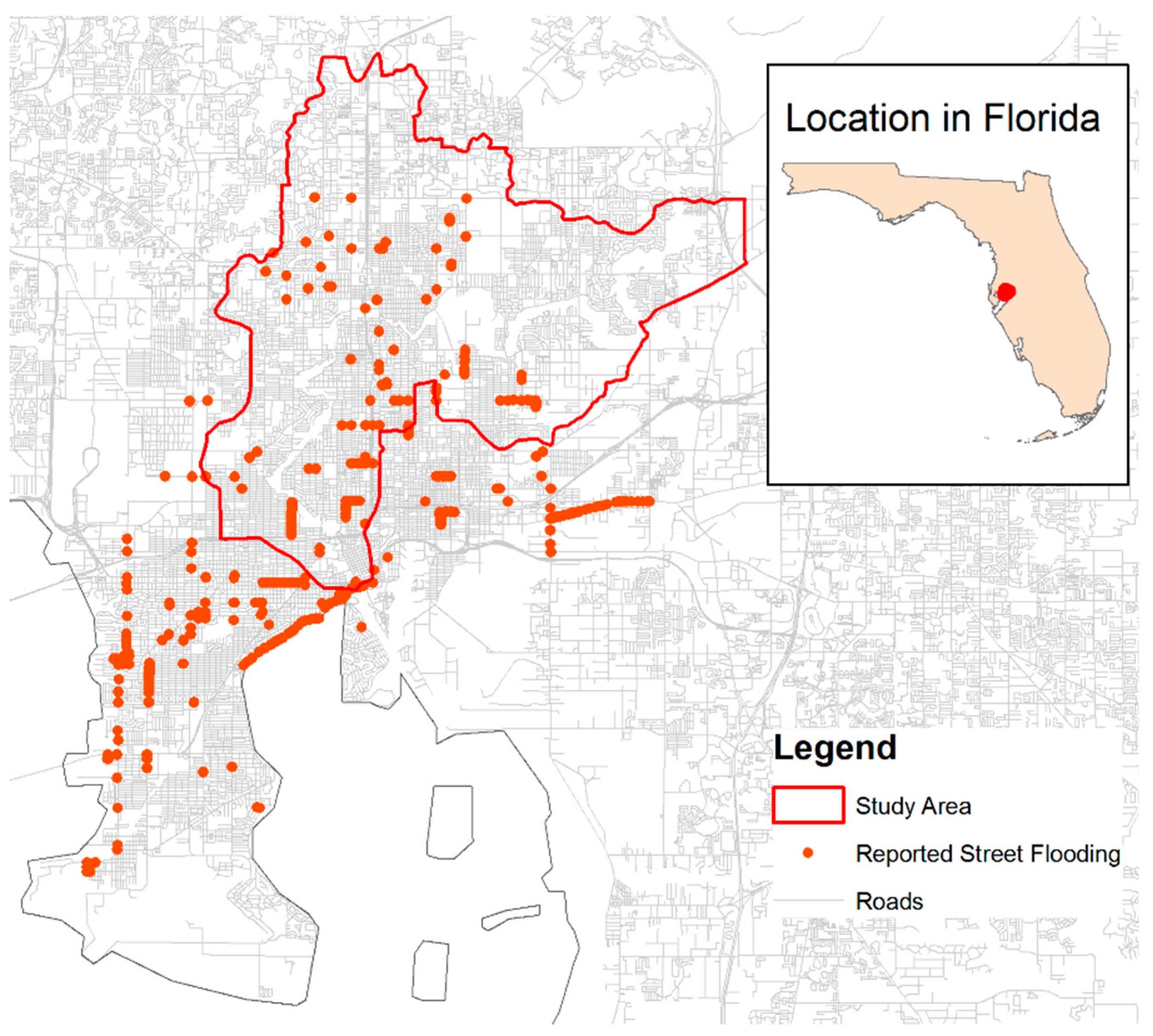
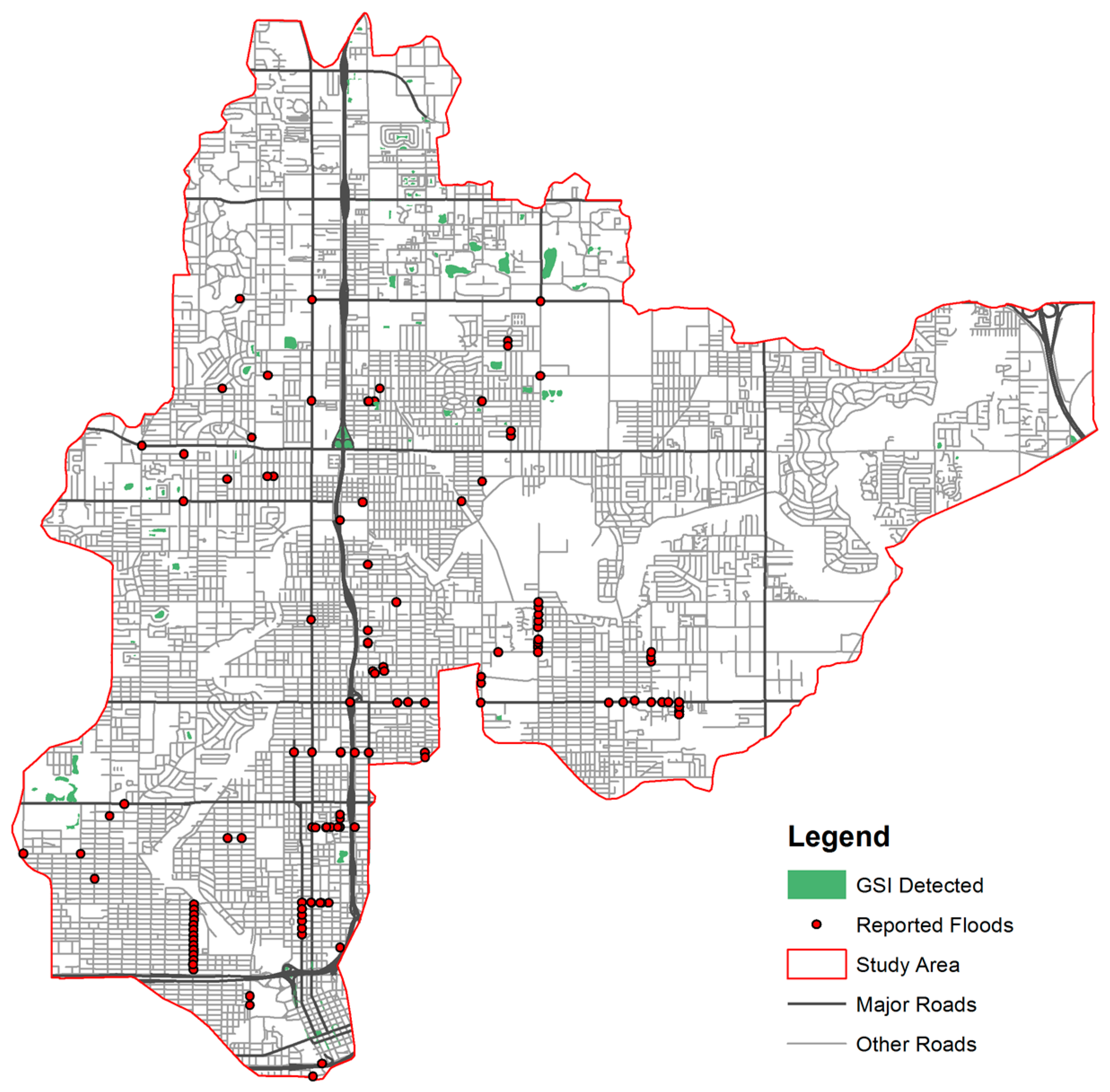
| Green Stormwater Infrastructure | Mechanism Type | Applied to Transportation Planning? If Yes, What Is the Common Place to Use? |
|---|---|---|
| Rain barrels/cisterns | Retention/detention | No |
| Bioretention cells/rain gardens | Filtration/retention | Yes, local roads |
| Dry/wet swales | Infiltration | Yes, local roads/ highways |
| Dry/wet ponds | Retention/detention | Yes, highways |
| Constructed wetlands | Detention | Rarely |
| Infiltration basin | Infiltration | Yes, highways |
| Infiltration trenches | Infiltration | Yes, highways |
| Vegetated filter strips | Filtration | Yes, highways |
| Sand filters | Filtration | Rarely |
| Riparian buffers | Filtration | Rarely |
| Permeable pavements | Infiltration | Yes, pedestrian pavements and parking lots |
| Downspout disconnection | Site design | No |
| Urban tree canopy | Site design | Yes, local roads and pedestrian pavements |
| Green roofs | Site design | No |
| Land conservation | Site design | No |
| Data | Produced Year | Source |
|---|---|---|
| Road centerline | 2017 | City of Tampa GeoHub [32] |
| Stormwater inlets | 2017 | |
| Stormwater discharge points | 2017 | |
| Stormwater open drains | 2017 | |
| Tampa land cover | 2011 | USF Water Institute [33] |
| Digital Elevation Models | 2007, 2010 | U.S. Geological Survey [34] |
| GSI Type | Count | Percent | Accuracy Assessment | |
|---|---|---|---|---|
| Producer’s | User’s | |||
| Basin | 42 | 31% | 89% | 91% |
| Swale | 64 | 47% | 86% | 89% |
| Bioretention cell/rain garden | 21 | 16% | 75% | 82% |
| Wetland | 6 | 4% | 100% | 100% |
| Tree Trench | 2 | 1% | 100% | 100% |
| Total | 135 | 87% | ||
| GSI Type | Count | Percent | Accuracy Assessment | |
|---|---|---|---|---|
| Producer’s | User’s | |||
| Basin | 46 | 35% | 86% | 89% |
| Swale | 60 | 46% | 88% | 92% |
| Bioretention cell/rain garden | 24 | 18% | 78% | 85% |
| Total | 130 | 86% | ||
| Type | Count | Average Surface Area (1000 ft2) |
|---|---|---|
| Dry pond | 5 | 93.0 |
| Bioretention cell/rain garden | 3 | 1.7 |
| Vegetated filter strip | 4 | 15.4 |
| Wet pond | 77 | 91.8 |
© 2018 by the authors. Licensee MDPI, Basel, Switzerland. This article is an open access article distributed under the terms and conditions of the Creative Commons Attribution (CC BY) license (http://creativecommons.org/licenses/by/4.0/).
Share and Cite
Xu, X.; Schreiber, D.S.P.; Lu, Q.; Zhang, Q. A GIS-Based Framework Creating Green Stormwater Infrastructure Inventory Relevant to Surface Transportation Planning. Sustainability 2018, 10, 4710. https://doi.org/10.3390/su10124710
Xu X, Schreiber DSP, Lu Q, Zhang Q. A GIS-Based Framework Creating Green Stormwater Infrastructure Inventory Relevant to Surface Transportation Planning. Sustainability. 2018; 10(12):4710. https://doi.org/10.3390/su10124710
Chicago/Turabian StyleXu, Xiaofan, Dylan S. P. Schreiber, Qing Lu, and Qiong Zhang. 2018. "A GIS-Based Framework Creating Green Stormwater Infrastructure Inventory Relevant to Surface Transportation Planning" Sustainability 10, no. 12: 4710. https://doi.org/10.3390/su10124710
APA StyleXu, X., Schreiber, D. S. P., Lu, Q., & Zhang, Q. (2018). A GIS-Based Framework Creating Green Stormwater Infrastructure Inventory Relevant to Surface Transportation Planning. Sustainability, 10(12), 4710. https://doi.org/10.3390/su10124710






